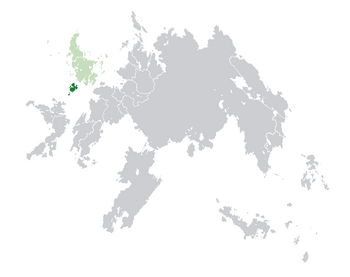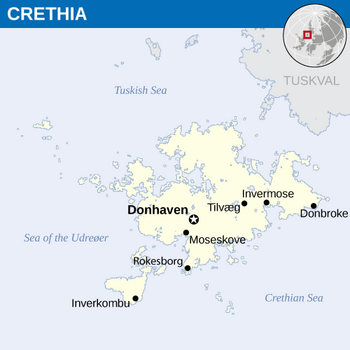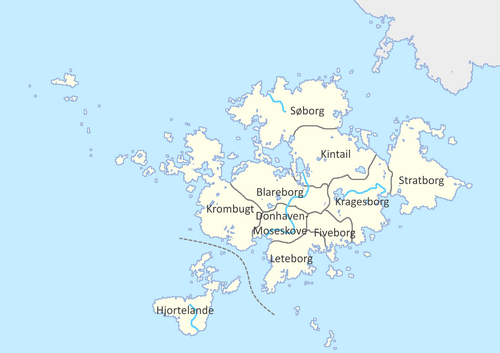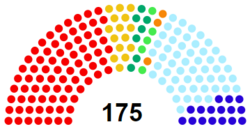User:Glitter/Crethia
Republic of Crethia Refoli af Krøtin | |
|---|---|
Motto: "Til mi Fædrelande" "For My Fatherland" | |
 Crethia (green) located in Asura. | |
 | |
| Capital and largest city | Donhaven |
| Official languages | Crethian |
| Recognised regional languages | Lhaeraidd |
| Ethnic groups | Crethian (88.3%) Lhaeraidd (5.6%) Other (6.1%) |
| Demonym(s) | Crethian |
| Government | Federal parliamentary republic |
• State President | Mia Hall |
• Chancellor | Donal Menzies |
| Legislature | Folketing |
| Establishment | |
• Unification | 1448 |
• Union with tir Lhaeraidd | 1598 |
• Kingdom of Crethia and Crylante | 1775 |
• Independence from tir Lhaeraidd | 1787 |
• Annexation by Lhedwin | 1799 |
• Independence and republic | 1901 |
| Population | |
• 2018 estimate | 5,200,000 |
• 2014 census | 5,093,649 |
| GDP (nominal) | 2015 estimate |
• Total | 203.04 billion |
• Per capita | 39,862 |
| Gini (2015) | 23.7 low |
| HDI (2015) | 0.934 very high |
| Currency | Stirling (CSL) |
| Date format | dd-mm-yy |
| Driving side | left |
| Calling code | +21 |
Crethia (Crethian: Krøtin), officially the Republic of Crethia (Crethian: Refoli af Krøtin), is an island country located off the northern coast of Asura. It shares a maritime border with Crylante, tir Lhaeraidd, and the Mardin Isles. Crethia is a small country, with an area of square kilometres. It has a population of 18.2 million and a low population density of inhabitants per square kilometre. Most of the population is located in urban centers on the main island along the banks of the River Hvid and the River Til, with approximately 75% of the country residing in urban areas.
Paithwaidh people have first settled in Crethia after migrating from the continent of Asura, with the Albi tracing their ancient origins back to the Lhaeraidd Paithwaidh. The Albi were a tribal people and established early confederations throughout modern day Crethia. Over time, Lhedwinic raiders in the early eleventh century. Over time, a fusion of the native Albi and the Nordic cultures and ethnic groups occurred. A number of petty kingdoms, dominated by a Lhedwinic nobility that adopted many local customs, emerged. Eventually, the country was unified by Alexander II, Duke of Donhaven, often remembered as Alexander the Great of Crethia. The First Kingdom of Crethia was established, bring all of the islands of the Crethian archipelago under the control of Donhaven. Following a succession crisis in 1598, the crown was won by the monarch of tir Lhaeraidd and a personal union was established. This lasted until 1775 when the Lhaeraidd monarch merged the kingdom with Crylante, which was also in union with tir Lhaeraidd. The Kingdom of Crethia-Crylante was established, but was met by broad opposition in Crethia. Many prominent nobles, merchants, and clerics opposed the union. Rebellion began soon after in 1776 when Vilhelm Noble-Surname was crowned King of Crethia. It spanned nearly two decades until Crethia regained independence in 1787. However, Vilhelm was killed during the revolt and the movement was left with no clear leader.
The Second Kingdom of Crethia was in regency for the entire duration of its existence. Two rival factions sat in the [proto-parliament name] and were unable to agree on a suitable candidate to sit on the throne. The regency council, led by Crethian nationalists, was regularly underminded by pan-Lhedwinic nationalists. After famine struck the islands, the pan-Lhedwinics gained support and ultimately took control of the regency council, offerring to crown to the King of Lhedwin. Crethia was officially annexed into the United Kingdom of Lhedwin in 1799. The Lhedwinic period saw a repression of Crethian nationalism, with a general de-Paithwaidhization taking place as the Lhedwinic-installed government sought to remove Paithwaidh influences from the language and culture. This caused controversy among many nationalists, who staged multiple failed uprisings throughout the century. The last and arguably most successful took place in 1872, which won concessions from the Lhedwinic government and the process of de-Paithwaidhization came to an end. Crethians participated in the Great War despite agitation from nationalists. After the defeat and collapse of the UKL, a nationalist revolt began with the intention of placing Margaret of Donhaven on the throne as queen. Before she could take power, she died during childbirth without issue. Crethia descended into crisis and civil war over the issue, which resulted in the victory of the republican faction and the establishment of a republic and constitution.
The country saw a renewed period of significant industrialization and urbanization during the beginning of the twentieth century. As a part of this process, there was a growing divide between provinces located on the main island (Fastlande) of the Crethian sub-archipelago and that make up the udreøer (outer-islands). The PKR established itself as the dominant-party of Crethia, securing an uninterrupted absolute majority in the Folketing from 1902 to 1966. Economic stagnation and rising unemployment, coupled with social issues, saw the PKR defeated for the first time. Crethia remained neutral during both the Second Great War and the Cold War and stills maintains a policy of neutrality. The country has close relations to its Lhedwinic neighbors, maintained through the Lhedwinic Council of which it is a founding member.
Crethia is a federal parliamentary republic, consisting of twelve provinces. The capital is Donhaven, which has an urban population of 944,667 people. The current president is Mia Hall, an Independent, who serves as head of state. Executive power is exercised by the Government, which is led by the chancellor, a post currently held by Donal Menzies (SP), and the cabinet. Legislative power is vested in the unicameral Folketing. Each province has its own legislature and a provincial governor, which exercise developed authority. Starting in 2014, the country was governed by a fragile coalition of the Progressive Conservatives and Republicans and the right-wing National Alliance, a right-wing party, led by chancellor Craig Kerr for four years. The government, which had been dogged by scandals, was defeated in the 2018 general election. The victory of the Social Democrats put Menzies' Social Democratic Party back in power as a minority government, propped up by a supply and confidence agreement with the Liberal Party.
Etymology
The name Crethia has its origins in the Gaelic name for the Albi people, Cruthaen. It is generally accepted that Cruthaen is the Goidelic version of Critani, which is the Britonnic name for the most powerful ancient Albi confederation. From Cruthaen, the Crethian Krøtin was derived. Crethia is the anglicized version of Cruthaen.
History
Early history
Lhedwinic settlement
Unification and the First Kingdom of Crethia
Union with tir Lhaeraidd
Second Kingdom of Crethia
United Kingdom of Lhedwin
Independence and Civil War
Republic and industrialization
Modern history
Politics
Governance
The governing doctrine of Crethia is its Constitution, which was drafted and ratified in 1837. It defines the federal system used to govern Crethia. It establishes three branches: the executive, legislative, and judicial branches. Likewise, it outlines the roles of provinces and their devolved branches of government.
The executive branch consists of the president, the chancellor, and the cabinet. The president is the head of state, meaning the role is largely ceremonial. The current President is Mia Hall, an Independent, and has held the post since 2015. Terms last for five years and presidents are popularly elected using a plurality vote. Typically, president's three primary tasks are conducting official state visits, receiving diplomatic credentials, and formally appointing the chancellor, cabinet, and other federal positions. However, all of these roles are filled by the government in the legislature. The largest party, or coalition of parties, in the Folketing form the government. The chancellor, the head of government, is chosen from among the MPs and puts together his or her cabinet. Donal Menzies is the current chancellor and is a member of the Social Democratic Party. He has served as chancellor since the 2018 general election. Likewise, chancellors nominate candidates to fill all federal posts, including those in the judiciary and various federal agencies. At least 75% of cabinet ministers must be sitting MPs and serve at the pleasure of the chancellor. Ministers oversee the fourteen federal departments.
 |
|
Government (77) Social Democrats (S) (77) Supported by Liberal Party (Li) (15) Opposition Progressives (PKR) (52) National Alliance (NA) (16) Farmers' Party (La) (7) Green Party (G) (5) Lhaeraidd Interest Party (LIP) (3) |
The Parliament of Crethia (Folketing af Krøtin) is the federal legislature and is unicameral. It has 175 members known as Members of Parliament who are elected through proportional representation. MPs serve a maximum four year terms and then it is mandated by the Constitution that fresh elections must be held. Snap elections may be held between the regularly scheduled elections. Federal elections always take place on the first Wednesday of September and under Crethian law voting is mandatory. Election day is also a federal holiday and is observed throughout the country in order to make it easier for citizens to comply with the mandate. There is a 5% threshold for parties to achieve representation in Parliament. In total, there are 175 seats, 88 of which are needed for a majority. Seats can be adjusted after the census if the government deems it necessary. Traditionally, for every 100,000 citizens there is one seat in Parliament. Currently there is a minority coalition between the Progressive Conservative and Republican Party and the National Alliance. The government is supported by the Farmers' Party. The Speaker of the Parliament presides over the legislature and is responsible for ensuring the agenda is kept. The government is always seated to the speaker's left. After the government is seated, parties are placed according to their location on the political spectrum from the speaker's left to right. The legislature is housed in the Folketing-Hos, located in Donhaven.
The judicial branch at a national level is made up of various levels of federal courts. The highest court of Crethia is known as the Landsret. It has appellate jurisdiction over all federal courts and over provincial court cases involving issues of federal law, plus original jurisdiction over a small range of cases. The Landsret alone has the final say on constitutionality, although it may only act within the context of a case for which it has jurisdiction. There are seven judges, known as Dommere (sin. dommer), that serve on the court. It is presided over by the Vigtigste Dommer while the remaining six judges are known as Medarbejderske-Dommere. They are appointed by the Furste and confirmed by Parliament. Once appointed, dommere have life tenure unless they resign, retire, or are removed after impeachment. Other national courts are known as Folkesret. The country is divided into five circuits, officially known as Folkesrondrejse. Provinces are grouped into circuits based on population, and jurisdiction may change with each census.
Political parties and elections
Foreign relations and military
Crethia maintains permanent diplomatic missions in over forty countries. Dozens of foreign countries maintain an embassy in Crethia, all of them are located in the capital, Crethia. There are also a number of consulates present in Crethia. When a new ambassador or consul is sent to Crethia by a foreign nation, they are received by the president to whom they present their letter of credence. Foreign policy is coordinated through the Department of Foreign Affairs, currently led by Secretary Elizabet Angusdoher. Traditionally, Crethian diplomats have been advocates for the creation and use of international institutions. As a small state, Crehtia relies heavily on these institutions to to carry out its foreign policy goals and ensure its security. Crethia is an advocate for inclusive international processes that bring national governments together.
Crethia is a founding member of the Lhedwin Council and several prominent prime ministers have advocated for increased cooperation among the Lhedwinic countries. It is also a participating member of the Aeian Environment Agency, the Aeian Public Health Organization, and the World Educational and Cultural Organization. International treaties are negotiated by the prime minister and voted upon by the Folketing, which in turn validates the terms of the treaty and binds the government to them. Following a failed referendum to join the Commonwealth of Democratic Nations, Crethian governments have been vocal critics of the organization. Former Crethian foreign secretary Jakob Ross called the CDN "one of the greatest setbacks since the Great War" as the CDN has authority it often exercises over countries who are not members or can not qualify as members. Crethia instead supports an international body in which all nations may participate and receive equal representation.
Administrative divisions
As a federal republic, Crethia is divided into ten provinces, known in Crethian as område. Each province has its own constitution, governor, and legislature. Devolved powers are granted to the provinces and their standing is made permanent by the 1837 constitution. Provincial legislatures differ in the organization, which is laid out in the constitution of each individual province. Each province is required to maintain an official flag and coat of arms, which it reserves the right to alter or replace by passing legislation. Provinces in the Fastlande (mainland) region of the country tend to be densely populated, while those in the Udreøer (outer-islands) are sparsely populated. Many of the provincial borders are rooted in the borders of the old counties (borgs), the former subdivisions of the monarchist states. Many have been condensed into larger provinces, while some such as Kragesborg and Leteborg maintain their old borders.
| Map | Name and shield | Administrative centre | Most populous municipality | Population | |
|---|---|---|---|---|---|
 |
Province (område) | ||||
| Blare | Clud | 1,706,584 | |||
| Tilvæg | Tilvæg | 2,814,983 | |||
| Robertebur | Robertebur | 211,123 | |||
| Donhaven | Donhaven | 3,694,667 | |||
| Fiv | Hjeme | 623,155 | |||
| Heteslande | Inverkombu | 510,216 | |||
| Melkirke | Melkirke | 228,717 | |||
| Invermose | Rokesburg | 2,639,047 | |||
| Angulborg | Duntopmøde | 140,749 | |||
| Strat | Dunbroke | 2,990,920 | |||
Economy
Transport
As a result of low population density, the scattered nature of the islands, and narrow shape and long coastlines of Crethia, its public transportation infrastructure is less developed when compared to many other nations in Asura. The country has a long history of maritime traditions, stemming from its geographic location. Many of its traditional transport routes are sea-based, connecting the islands that make up the Crethian archipelago. In recent decades, the government has worked to expand links between major population centers and with neighboring countries through a combination of road, rail, and air travel. The Department for Transport and Infrastructure oversees government policy for transportation. A recent trend of privatization as seen a scaled back role for the department, as public ownership came to an end.
Ferry services play a crucial role in Crethian public transport. Dozens of ferry links link the nation's many islands together, providing access for residents of remote islands to major urban areas such as Donhaven and Tilvæg. Ferry connections also allow for easy travel through the four major rivers, along which many major cities are located. Regular ferry services operate between the main islands and the outlying islands. Longskib is the largest of provider of services, focusing primiarly on routes linking the western islands with the rest of the country. Other routes, served by multiple companies, connect Crethia to the Asuran mainland, the Mardin Isles, and Lhedwin. Some provincial and local authorities operation additional routes.
The main railway network of 2,733 km standard gauge lines, of which 122 kilometres are double-tracked and 53 km is high-speed rail. The majority of the Crethian network is concentrated on the main island, with some smaller lines operating else where Krøtjernbane operates all intercity, commuter, and freight railway services in the country. Donhaven is the center of the network with its large station, Sistend, linking to the cities and main towns on the main island. Several small companies provide regional freight services. Investment in new infrastructure and maintenance is financed through the national budget, and subsidies are provided for passenger train operations. Subsidies are provided for passenger train operations, especially for less frequently traveled lines. The provincial government of Donhaven-Moseskove operates an inner-city light rail network in conjunction with local authorities.
In total, there are 74 airports in Crethia, many of which are small airports in remote areas with limited operations. Provincial and local governments operate 47 airports. The gateway to Crethia by air is Donhaven International. However, a number of other airports receive over one million passengers annually. A total of 35,105,969 passengers passed through Crethian airports in 2010, of whom 10,713,201 were international. Donhaven is the hub for Krøtinsk Flyselsannrer, a subsidiary of Jahaza. There are departures to most Asuran countries in addition to some intercontinental destinations.
Demographics
The first Paithwaidh people arrived in Crethia following the migration of early Lhaeraidd Paithwaidh northward. The Albi were the first native Paithwaidh group and lived in modern day Crethia exclusively until Lhedwinic peoples from Lhedwin conquered the region in the early eleventh century. Over time, a fusion of the native Albi and the Lhedwinic cultures and ethnic groups occurred, resulting in the creation of the modern day Crethian people. The Crethian language also has its origins in this cultural fusion. As such, Crethia is considered a Paithwaidh-Lhedwinic state. When discussing Crethian culture, one prominent academic said that it is "Paithwaidh when convenient, and Lhedwinic when convenient".
Today, roughly 88% of the population identifies as ethnically Crethian as of the 2014 census. The biggest minority group within Crethia is Lhaeraidd, with 5.6% of the population identifying as such. The majority of the Lhaeraidd population, which as of 2014 is 985,244, resides within the province of Leteborg, which has historically exchanged hands between tir Lhaeraidd and Crethia. In recent years, Lhaeraidd political movements have been launched, with the most notable being the Lhaeraidd Interest Party. Other significant ethnic groups are x and y.
| Rank | Province | Pop. | |||||||
|---|---|---|---|---|---|---|---|---|---|
 Donhaven  Moseskove |
1 | Donhaven | Donhaven-Moseskove | 944.667 |  Rokesborg  Tilvæg | ||||
| 2 | Moseskove | Donhaven-Moseskove | 635.606 | ||||||
| 3 | Rokesborg | Leteborg | 524.035 | ||||||
| 4 | Tilvæg | Kragesborg | 342.021 | ||||||
| 5 | Invermose | Leteborg | 226.451 | ||||||
| 6 | Dunbroke | Stratborg | 214.112 | ||||||
| 7 | Harborg | Sudlande | 201.462 | ||||||
| 8 | Stenhvid | Stratborg | 200.276 | ||||||
| 9 | Clud | Blareborg | 182.788 | ||||||
| 10 | Inverkombu | Kragesborg | 173.349 | ||||||








